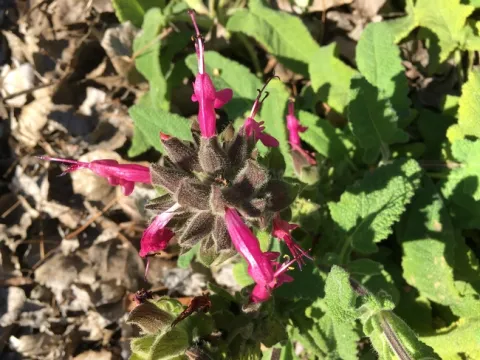Salvia Spathacea

Salvia Spathacea
By Linda Lewis Griffith UCCE Master Gardener
Common Name: Hummingbird Sage, Pitcher Sage
Planting Zone: Sunset 7-9, 14-24
Size: 1-2 ft. high, spreading 3 or more feet in width
Bloom Season: March through June, with some repeat blooms in fall
Exposure: Full sun to partial shade
Pruning Needs: Option to trim back flower stalks after blooming
Water Needs: Drought tolerant, but prefers occasional water. Tolerates regular garden water
Narrative:This hardy, low-growing California native thrives in coastal woodland communities from Sonoma County south to Orange County. It is frequently found among native oaks and on grassy slopes often close to the Pacific Ocean. It is hardy to 20 degrees F. Salvia spathacea is a sprawling, perennial herb with deep green, lance-shaped leaves that are 4-6 inches long. Foliage has a distinctive fruity aroma and was the source of a decongestant tea made by Aboriginal Californians. Tall, vigorous spikes covered in magenta-red flowers appear in early spring. While the blooms are irresistible to hummingbirds, they are also a source of food and nectar for assorted bees, butterflies and caterpillars. Hummingbird sage is easy to grow, tolerating a variety of well-drained soils and irrigation schedules and requires minimal maintenance. Even though S. spathacea dies back when water is scarce, its system of strong, underground rhizomes allow it to survive long periods of drought. Hummingbird sage makes a perfect, self-generating ground cover and is ideal in any habitat meant to attract wildlife. It is also resistant to deer. It can be planted under trees or large shrubs, such as Coast Live Oaks, Bay Laurel and Madrone. It can also be used as a companion for other understory plants, such as California Peony, Yerba Buena, Ocean Spray, Miners Lettuce and Canyon Sunflower. S. spathacea is readily propagated by either seeds or rhizomes. Sow seeds directly into the soil in fall. Or divide larger plants into individual rhizomes, taking care that each segment has several good-sized roots. Plant rhizomes in pots or directly in the soil, keeping them uniformly moist until established. The name Salvia is derived from the Latin word salvus meaning safe, well or sound and refers to the medicinal properties attributed to this genus.
